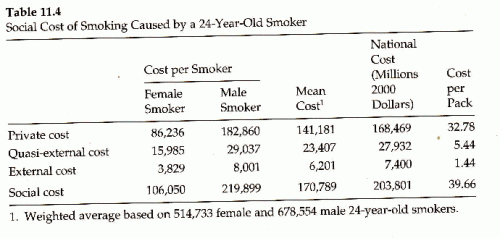I talked with a reporter last week who asked me a simple question:
- do smokers actually save society money because they die sooner?
The short answer is no, smoking imposes large costs on society. However, as I talked with the reporter, I realized that he had many questions underneath this simple one, that not only related to aggregate or net costs (social cost), but to the distribution of costs (who bears the burden).
I am going to do a series of posts looking at the cost of smoking to society, based on a book that I wrote with Frank Sloan and others (The Price of Smoking, MIT Press, 2004). Our book provides a comprehensive life cycle estimate of the social cost of smoking. This was done by taking the present value of the life cycle stream of private, external, and quasi-external costs for a 24 year old smoker (all costs shown in 2000 dollars). Using many sources of data, we created smoking life tables, and also provide a detailed accounting not only of net costs, but of various cross subsidies that exist. The NPV social cost of a 24 year old smoker was around $220,000 for men, and $106,000 for women. Our calculations account for the purchase cost of cigarettes as well as excise taxes paid. The bottom line of $171,000 shown below is a mean social cost of smoking for a 24 year old smoker, weighted by gender (table 11.4 of the book (p. 257):
We further estimated that the social cost of smoking in 2000 was around $40/pack of cigarettes, distributed as follows:
- $33 private cost: borne by the individual, primarily through a substantially shortened lifespan
- $5.50 quasi-external cost: borne by the smokers’ family through increased health costs, slightly lower wages and other factors
- $1.50 external cost: borne by society, and representing the net effect of things like taxes paid, Medicaid and Medicare payments, and Social Security received
Our estimates show that smoking imposes very large social costs. It is true that a large proportion of the costs are borne by the smoker themselves (what we called private costs), which could lead someone to think that this is mostly a private decision and not a matter of public policy. However, there are other costs, some borne by a smoker’s family (we called them quasi-external costs), including children, and others borne by society as a whole (external cost). And the relatively small magnitude of external costs as compared to private ones obscures the sheer size of the external costs of smoking. Our estimates imply a total external cost of a cohort of 24 year old smokers at $35 Billion over their lifetime ($7 Billion for external, plus $28 Billion for quasi-external). Note that this is an incidence cost, so for each cohort (the next year of smokers and so on) there is another $35 Billion in external costs imposed by smoking.
For the remainder of the series, I am going to delve more deeply into what we measured (and didn’t measure) to estimate private costs, quasi-external costs, and external costs. I will also identify cross-subsidies of one program versus another that may be of more interest to some than even the net, or the social cost. Finally, I will describe how our book can and cannot be used to answer direct policy questions like ‘should a given state charge smokers a higher cost share in Medicaid?’ Or, ‘should cigarette excise taxes be raised?’
Other Posts in this series addressed the components of the social cost of smoking:
- Private costs, June 8, 2011
- Quasi-external costs, June 9, 2011
- External costs, June 10, 2011
- What was excluded, September 14, 2011
Full citation: Frank A. Sloan, Jan Ostermann, Gabriel Picone, Christopher Conover and Donald H. Taylor, Jr. The Price of Smoking. MIT Press: 2004. The Price of Smoking is available as an ebook.


